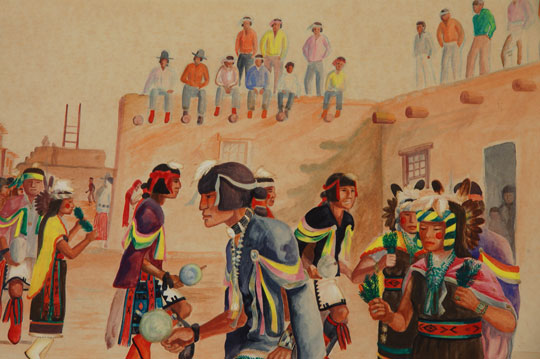Original Painting of a Hopi-Tewa Plaza Dance [SOLD]
+ Add to my watchlist Forward to Friend
- Category: Paintings
- Origin: Hopi Pueblo, Hopituh Shi-nu-mu
- Medium: casein
- Size: 12-1/2” x 19-1/2” image; 22-1/4” x 29-1/4” framed
- Item # C3219P SOLD
Hopi-Tewa artist Raymond Naha was born at Polacca, which is at the foot of First Mesa, on the Hopi Reservation in Arizona on December 5, 1933. He studied with Fred Kabotie at Oraibi High School. Kabotie recognized Naha's talent and encouraged him to continue his studies. Naha then took correspondence courses and studied at the Phoenix Indian School. His paintings are characterized by the depiction of details of Hopi ceremonial life in a vibrant and colorful manner. His work reflects more of a European influence than other Native American painters of the time. He was one of the first to break away from the traditional Dorothy Dunn style and use more colors and diverse backgrounds.
Naha continued to paint traditional subjects such as dancers and village life, but used a stronger, more inventive pallet, often painting night scenes with dark blue and grey hues. He is best known for his ability to paint even the smallest aspects of Hopi life in the most exquisite detail. Feathers, green bough, sashes, kilt embroidery and other costume details are exquisitely executed. He was exhibited widely and has won numerous awards including the Indian Arts Fund in Santa Fe in 1962. He died in 1975 at the age of 42.
The color palette of this painting of a Plaza Dance is typical of Naha's brilliant use of color. The detail of the costumes is ethnographically correct and executed with utmost care. Take notice of the velvet shirts with ribbons and how they reflect the movement of the dancers. The drummers and chanters are so animated that one can hear the drum beats and songs.
Condition: The painting appears to be in original condition
Provenance: from the collection of Katherine H. Rust
Recommended Reading: Southwest Indian Painting: a changing art by Clara Lee Tanner

- Category: Paintings
- Origin: Hopi Pueblo, Hopituh Shi-nu-mu
- Medium: casein
- Size: 12-1/2” x 19-1/2” image; 22-1/4” x 29-1/4” framed
- Item # C3219P SOLD



